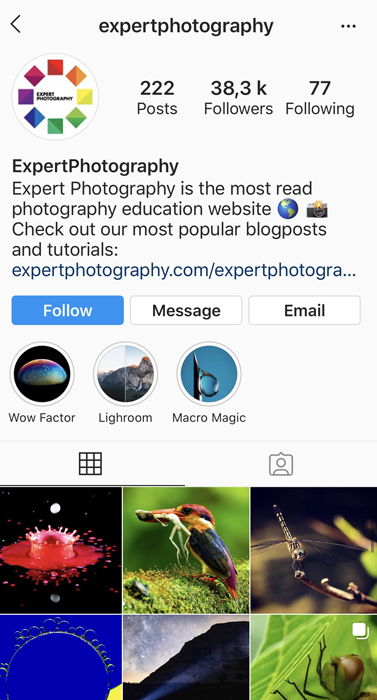[ExpertPhotography is supported by readers. Product links on ExpertPhotography are referral links. If you use one of these and buy something, we make a little bit of money. Need more info? See how it all works here.]
1. Social Media Marketing For Photographers: Choosing Between Niche Appeal or Diversification for Consistency
The niche appeal marketing strategy is popular with photographers who specialise in one field. Niche appeal means creating a brand that appeals to a particular demographic. This can be a color scheme, a style, or subject matter. Anything that is characteristic of your photography business in an obvious way works. But for this strategy to work, all your social media content must follow it. It must be tailored to represent a very recognisable and particular aesthetic. All your hashtags should also target only the people that are drawn to that theme. Those are the ones likely to stick around and click ‘follow’. There are several benefits to niche appeal social media strategies. Clients interested in booking you or buying your courses will know what to expect. The downside is that you might find yourself stuck in your niche with not enough clients interested in what you’re offering. Here’s where a diversification strategy might prove more helpful. With diversification, you can attract a larger number of followers. You’ll be offering a large variety of photography if you choose to diversify. Your appeal is that you do everything and that you can adapt to anything your client might request. Your social media feed can encompass all the different work that you do. The best way to approach this strategy is to assign different days to different subjects. This keeps your content new and interesting. The downside to diversification is that it can put off some clients. This can, at times, cause you to lose business.
2. Interact With People to Increase Your Follower Base
Social media is for interaction and engagement. The original purpose of many of the social media platforms was to connect users. This includes Facebook, Instagram, Twitter, etc. A great strategy for gaining new followers and fans is to be interactive. Talk to the people viewing your work, and respond to all the comments. Share some of the social media love by ‘liking’ your followers’ posts. You can also utilise the more personal approach of posting stories on Instagram and Facebook. Ask your followers questions. This is an excellent way to be more interactive with them and encourage engagement. Use every photograph you post as an opportunity for interaction. Ask your followers to share their stories and opinions. Or even their own photos! On a sneaky note, this allows you to gauge your potential (or current) client’s aesthetics. You can then modify your business model to attract brand loyalty. The downside of this strategy is that it is very time-consuming.
3. Be Relatable to Gain Valuable Followers
The more relatable you are, the higher the likelihood of gaining significant business and repeat customers. This is Marketing 101. It is true for social media platforms as well. But in a different way. Followers want to feel like they can relate, understand, and have a kinship with you. In certain ways, they want to get to know you. This is the reason big companies often create a ‘personality’ for their brands. Being relatable is a common and brilliant social media strategy. Companies, individuals and brands use it all the time. For photographers, a great way to create more relatable content is to let your personality shine. For example, take behind the scenes photographs! Make commentary on your photography process. And take selfies with your camera gear. If you have any hobbies, take a few professional quality images of what you like to do. Show parts of your life that people can connect with. This strategy comes with an added bonus. Clients will feel more comfortable with you if they feel like they know you a little better. It may seem silly. But sharing on social media makes strangers feel more like friends. This strategy can work both for current and potential clients who follow your accounts. They’ll be more comfortable around you during the shoots. And your photographs will be better. The downside of this strategy is that not everyone will enjoy what they learn about you. That doesn’t mean you are not an excellent photographer. But you cannot please everyone.
4. Use Trending Hashtags and Topics to Fit Current Happenings
This is a quick, easy, and fun way to engage in social media culture. You need to be up to speed with relevant hashtags and current trending topics. Then you should cater some of your work to fit current happenings. This can be a brilliant way to get your photography in front of millions of brand new eyes. Hashtags are words or phrase preceded by a hash or pound sign (#). These are used to identify messages on a specific topic. By adding hashtags to your image, you are categorizing it. Users can click on the hashtag to see other images within that group. This is how your image becomes part of public viewing. There are many hashtags dedicated to certain industries, days of the week, or months of the year. Here’s a complete guide to using hashtags for photography. Popular hashtags for photographers on Instagram, Twitter, and Facebook include: #collectivelycreate, #shutterbug, #photographerlife, #photographysouls and more. Some of the commonly used days-of-the-week hashtags include: #throwbackthursday, #flashbackfriday, #sundayfunday, and many more. By tailoring your social media content to be relevant to these tags, you can find a large range of new fans. A trending topic experiences a surge in popularity on one or more social media platforms. This only happens for a limited duration of time. Trending topics can include news stories, seasons, popular music or television shows. Try doing regular Google searches, exploring social media feeds and seeing what is out there. The disadvantage of this strategy is that you can end up getting caught up in it. Some spend too much time trying to adhere to current hashtags and topics. They lose some of their artistic vision in the process.
5. Embrace Your Brand to Stay Consistent
Sometimes the best strategy means going back to business basics. You’ll need to have or build a very solid and recognisable brand. You can use social media to embrace your brand and sell the lifestyle that is associated with it. This is true for photographers too. Photography sells an experience as much as it does final images. You can do this in a variety of ways, from creating niche content to fun behind-the-scenes clips.
6. Be Active in the Relevant Online Communities
Instead of twiddling your thumbs and waiting for the community to come to you – go to the community! The whole point of social media is to be able to engage with a tribe of people all over the world. Start being active in the online community that caters to what you do, who you are, and where your demographic hangs out. This is an excellent way to build a massive following. Plus, you can learn a thing or two from your peers. This is the strategy I most recommend to include as part of your social media campaign. It can increase your recognition, help you grow as an artist, and meet like-minded individuals. On Facebook, you can use ‘groups’. These connect you to a massive amount of communities you can become a part of. Join several that strike your fancy or your business’s fancy. Then start commenting, posting, and participating. Use Instagram and Twitter’s hashtag system. That way, you can find users that are into the same things you are and engage with them. On Instagram, you will also have the option to submit your images to certain online magazines and collectives. This can boost your overall popularity and reputation amongst the industry professionals.
7. Figure Out the Goal of Your Strategy First
All social media strategies need to start with a goal in mind. For many photographers, the intent is to expand their photography brand and become better known. With your name and portfolio out there for the masses to see, the recognition can be invaluable. It can lead to a significant amount of photography work and client retention. But you should break that down. Start thinking about what kind of clients you’re seeking and what kind of recognition you want. A good way to outline a mini-business plan for your social media career is to use the intent as your header. Then add various goals that expand upon your needs. For example: Intent – gain more recognition to acquire more clients. Goals – find more dog owners in Los Angeles that would be interested in my services. Reach 1,000 followers in the California state. With this plan in mind, you can find the best strategy or a mixture of strategies that fit your goals.
8. Produce Quality Content to Stay Relevant
The definition of quality content is a bit different in a social media sense. Quality content is a proficient, beautiful image taken with a professional camera. Right? Yes, but when it comes to social media, there’re some other important aspects:
The content is informational, or expresses an idea; The content is highly entertaining and shareable; The content is unique; The content provides value to the viewer; The content is personal and empathetic; The content is optimised for SEO (optional, depending on the social media platform).
These characteristics can be subjective. But there’s one way to know for sure if it does or doesn’t. Keep an eye on how your fans interact (or don’t interact) with your post. That’ll tell you everything you need to know.
9. Adapt Your Strategy for Each Platform
Each social media platform has a speciality. Adapting your content is the key to getting the right kind of user interaction. Instagram caters to images and prefers image content over anything else. It wants users to engage with photos. But it doesn’t encourage conversation. Facebook is more of a conversational and sharing platform. It wants people talking to each other more than images. Twitter wants quick, snappy snippets of people’ day to day life. And YouTube is for video content only. When choosing a social media strategy, keep these things in mind. An interactive approach might be best for Instagram and Facebook, but not for Twitter.
10. Schedule Your Posts to Be More Visible
Don’t forget about being consistent. This might sound tedious. But knowing that they can expect a post from you every day will make your followers stick around. But don’t go overboard. Posting all the time won’t do you any good if you’re not posting at the proper time. If you post at 3 am, when the majority of your fans are sleeping, no one will see it! Try to schedule your posts around the times when people will see it. On weekdays, try to post during lunch hours or after working hours. Avoid posting when your following might be stuck in rush hour traffic, at work, or still sleeping. On weekends, account for the fact that many people like to go out and party on Saturday and sleep in on Sunday. If you use services like Instagram Business you’ll be able to track down the activity of your followers. Try to get around posting at the time when people are less likely to be on their phones. And keep in mind that holidays may result in lower engagement across the board.
11. Avoid Fake Interactions to Stay Authentic on Social Media
Authenticity is a very important concept in social media. Deceiving your users about who you are will come back to bite you later on. Be yourself, express your voice, and show your own individual artistic vision. Do try partnering with other accounts, photographers, brands, and businesses. This way, you can cross-promote each other and share the love. And don’t cheat. Buying fake followers or engagement is an easy way to throw money down the drain, and it isn’t fooling anyone. Instead of this make a smarter investment. Try to launch paid campaigns to promote your work. The fake interaction will also mess up your market research!
Conclusion
Now that you have these social media marketing strategies in your arsenal, go make the most of social media! Photographers need a social media presence for their business. Your social media marketing strategy will influence your success in the business field. Find goals to achieve. Then plan your social media actions with care. Last but not least, measure the outcome to see what you are doing well and what you could do better!














